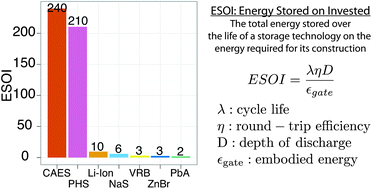On the importance of reducing the energetic and material demands of electrical energy storage†
Abstract
Two prominent low-carbon energy resources, wind and sunlight, depend on weather. As the percentage of electricity supply from these sources increases, grid operators will need to employ strategies and technologies, including energy storage, to balance supply with demand. We quantify energy and material resource requirements for currently available energy storage technologies: lithium ion (Li-ion), sodium sulfur (NaS) and lead-acid (PbA) batteries; vanadium redox (VRB) and zinc-bromine (ZnBr) flow batteries; and geologic pumped hydroelectric storage (PHS) and compressed air energy storage (CAES). By introducing new concepts, including energy stored on invested (ESOI), we map research avenues that could expedite the development and deployment of grid-scale energy storage. ESOI incorporates several storage attributes instead of isolated properties, like efficiency or energy density. Calculations indicate that electrochemical storage technologies will impinge on global energy supplies for scale up — PHS and CAES are less energy intensive by 100 fold. Using ESOI we show that an increase in electrochemical storage cycle life by tenfold would greatly relax energetic constraints for grid-storage and improve cost competitiveness. We find that annual material resource production places tight limits on Li-ion, VRB and PHS development and loose limits on NaS and CAES. This analysis indicates that energy storage could provide some grid flexibility but its build up will require decades. Reducing financial cost is not sufficient for creating a scalable energy storage infrastructure. Most importantly, for grid integrated storage, cycle life must be improved to improve the scalability of battery technologies. As a result of the constraints on energy storage described here, increasing grid flexibility as the penetration of renewable power generation increases will require employing several additional techniques including demand-side management, flexible generation from base-load facilities and natural gas firming.


 Please wait while we load your content...
Please wait while we load your content...